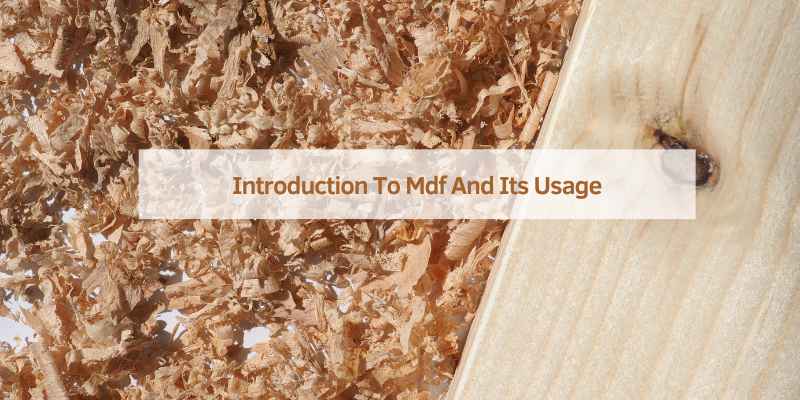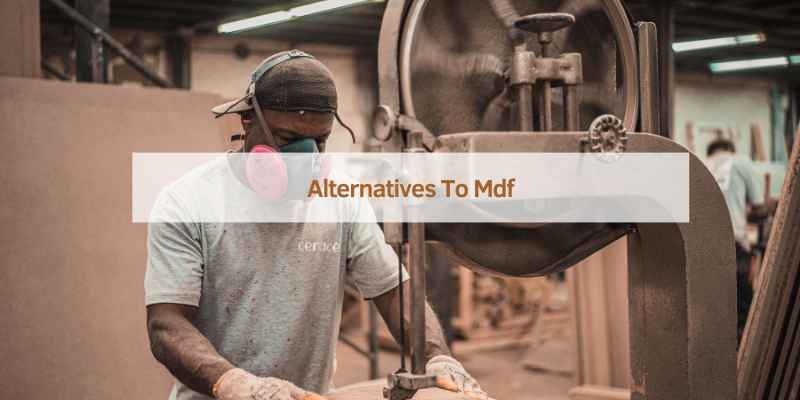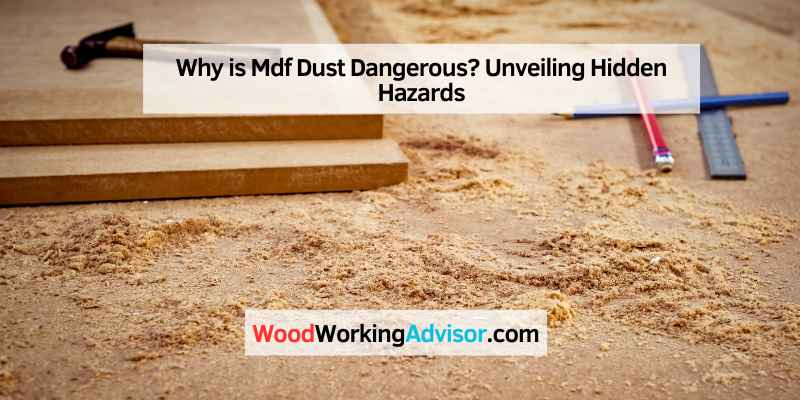MDF dust is dangerous because it contains formaldehyde, a known carcinogen, and can cause respiratory issues. Inhalation of MDF dust can lead to serious health problems.
Medium Density Fiberboard (MDF) is a popular material in construction and furniture making due to its affordability and versatility. Despite its advantages, working with MDF poses health risks primarily from the dust it generates. MDF is made by breaking down hardwood or softwood residuals into wood fibers and combining them with wax and a resin binder containing formaldehyde.
Cutting, sanding, or drilling MDF releases fine dust particles into the air, which can be easily inhaled. Prolonged exposure to MDF dust can cause respiratory irritation, asthma, and even increase the risk of cancer. Proper ventilation and protective gear are essential when working with MDF to safeguard health.
Introduction To Mdf And Its Usage
MDF, or Medium-Density Fiberboard, is a popular material in many industries. It is known for its versatility and cost-effectiveness. But, there are dangers associated with MDF dust that many might not know.
What Is Mdf?
Medium-Density Fiberboard (MDF) is an engineered wood product. It is made by breaking down hardwood or softwood residuals into wood fibers. These fibers are then combined with wax and a resin binder. The mixture is formed into panels by applying high temperature and pressure.
MDF is denser than plywood. It is often preferred due to its smooth surface and easy machinability. But, working with MDF produces a significant amount of dust, which can be harmful.
Common Uses Of Mdf
MDF is widely used in various applications. Here are some of the common uses of MDF:
- Furniture: MDF is used to make cabinets, shelves, and other furniture pieces.
- Flooring: It serves as an underlayment for floors due to its stability.
- Doors: Many interior doors are made from MDF because it is easy to shape and paint.
- Decorative Projects: It is used for moldings, trims, and other decorative elements.
MDF’s versatility makes it a favorite material in homes and businesses. But, the dust produced during cutting, sanding, or drilling can pose health risks.

Composition Of Mdf
Medium Density Fiberboard (MDF) is a popular material in furniture and construction. Understanding its composition is key to knowing why MDF dust is dangerous. MDF is made from wood fibers mixed with resins and waxes.
Ingredients In Mdf
MDF consists mainly of wood fibers. These fibers come from both hardwood and softwood. The fibers are broken down into a fine consistency. This allows for a smooth and dense board.
In addition to wood fibers, MDF contains resins and waxes. These ingredients help bind the wood fibers together. The result is a strong and stable panel.
| Ingredient | Purpose |
|---|---|
| Wood Fibers | Main component, provides structure |
| Resins | Bind wood fibers together |
| Waxes | Improve moisture resistance |
Chemicals In The Bonding Process
The bonding process involves several chemicals. Urea-formaldehyde resin is the most common binding agent. This resin helps create a strong and durable board. Formaldehyde can be harmful when inhaled. High levels of exposure can cause serious health issues.
Other chemicals used include phenol-formaldehyde and melamine-formaldehyde. These chemicals also release formaldehyde gas. This gas can irritate the eyes, nose, and throat. Long-term exposure can lead to more severe health problems.
MDF dust is dangerous because it contains fine wood particles and harmful chemicals. These particles can stay in the air for a long time. Breathing in this dust can cause respiratory issues.
Health Risks Of Mdf Dust
Medium Density Fiberboard (MDF) is a common building material. It is made from wood fibers mixed with resin. Cutting or sanding MDF releases fine dust particles into the air. These particles can pose several health risks. Let’s explore the health risks associated with MDF dust.
Respiratory Issues
Inhaling MDF dust can cause respiratory problems. These fine particles can enter the lungs and cause irritation. People with asthma or allergies are at higher risk. Symptoms may include coughing, wheezing, and shortness of breath. Long-term exposure can lead to chronic respiratory diseases. Always wear a mask to protect your lungs. Ensure proper ventilation in the workspace.
Skin And Eye Irritation
MDF dust can also affect your skin and eyes. Direct contact with MDF dust can cause redness and itching. Washing the affected area with soap and water can help. Wearing gloves can prevent skin irritation.
MDF dust can irritate the eyes as well. Symptoms may include redness, itching, and watering. Rinse your eyes with clean water if they come into contact with MDF dust. Wearing safety goggles can provide protection.
| Health Risk | Symptoms | Protection |
|---|---|---|
| Respiratory Issues | Coughing, Wheezing, Shortness of Breath | Wear a Mask, Ensure Ventilation |
| Skin Irritation | Redness, Itching | Wear Gloves, Wash Skin |
| Eye Irritation | Redness, Itching, Watering | Wear Safety Goggles, Rinse Eyes |
Carcinogenic Potential
Understanding the carcinogenic potential of MDF dust is vital for health. MDF, or medium-density fiberboard, is widely used in construction. It contains formaldehyde, a known carcinogen. Prolonged exposure to MDF dust poses significant health risks.
Formaldehyde Exposure
Formaldehyde is a common binder in MDF. Its emissions can cause serious health issues. When cutting or sanding MDF, dust particles release formaldehyde into the air. Workers inhale these particles, exposing themselves to harmful chemicals. Symptoms of exposure include respiratory problems, skin irritation, and eye discomfort.
To highlight the risks, consider the following table:
| Exposure Level | Health Effects |
|---|---|
| Low | Mild irritation of eyes, nose, and throat |
| Moderate | Respiratory issues and allergic reactions |
| High | Increased cancer risk and severe health problems |
Long-term Cancer Risks
Long-term exposure to MDF dust can increase cancer risk. Formaldehyde is classified as a human carcinogen by health organizations. Workers in industries using MDF face higher risks of developing cancers. These include nasal, throat, and lung cancers.
Reducing exposure is critical. Use protective gear like masks and goggles. Ensure good ventilation in workspaces. Regular health check-ups can also help in early detection of potential health issues.
- Wear protective gear: Masks and goggles can minimize dust inhalation.
- Ensure good ventilation: Proper airflow reduces dust concentration.
- Regular health check-ups: Early detection of health issues is crucial.
Safety Measures For Handling Mdf
MDF (Medium-Density Fiberboard) is a popular material in woodworking and construction. Despite its usefulness, MDF dust can be dangerous. Taking safety measures is crucial for handling MDF safely. This section will guide you on important safety measures.
Personal Protective Equipment
Wearing the right Personal Protective Equipment (PPE) is essential. Use a high-quality dust mask or respirator. This protects your lungs from harmful particles. Safety goggles shield your eyes from dust. Wear long sleeves and gloves to protect your skin.
| Equipment | Purpose |
|---|---|
| Dust Mask or Respirator | Protects lungs from harmful particles |
| Safety Goggles | Shields eyes from dust |
| Long Sleeves and Gloves | Protects skin from contact with dust |
Ventilation And Dust Extraction
Having proper ventilation and dust extraction systems is crucial. Work in a well-ventilated area. Use fans to keep the air moving. Install an efficient dust extraction system. It should capture dust at the source.
- Ensure your workspace has open windows.
- Use a fan to circulate air.
- Install a dust extraction system to capture dust.
Regularly clean your workspace. This reduces the buildup of MDF dust. Use a vacuum with a HEPA filter. It effectively removes fine dust particles. Avoid sweeping, as it stirs up dust into the air.
- Work in a well-ventilated area.
- Use fans to keep air moving.
- Install a dust extraction system.
- Regularly clean your workspace.
- Use a vacuum with a HEPA filter.
- Avoid sweeping to prevent dust from spreading.
Legal Regulations On Mdf Dust
DF dust is hazardous. Legal regulations exist to protect workers. These rules ensure safety in workplaces handling MDF.
Workplace Safety Standards
Workplaces must follow strict safety standards. These rules reduce exposure to MDF dust. Organizations like OSHA set these standards. They require proper ventilation and dust control systems. Employers must provide personal protective equipment (PPE) to workers.
Regular training is essential. Workers must know how to handle MDF safely. This training includes using PPE correctly. It also covers emergency procedures. Regular health checks are also necessary. They monitor workers’ health and detect early signs of exposure.
Material Safety Data Sheets
Material Safety Data Sheets (MSDS) are critical. They provide detailed information about MDF. MSDS includes hazard identification and safety measures. Employers must keep MSDS accessible to all workers.
| Section | Information |
|---|---|
| 1 | Product Identification |
| 2 | Hazard Identification |
| 3 | Composition/Information on Ingredients |
| 4 | First-Aid Measures |
| 5 | Fire-Fighting Measures |
| 6 | Accidental Release Measures |
| 7 | Handling and Storage |
| 8 | Exposure Controls/Personal Protection |
MSDS ensures workers are aware of the risks. They also provide steps to minimize exposure. Knowing this information keeps everyone safe.
Proper Disposal Of Mdf Waste
Medium Density Fiberboard (MDF) dust poses serious health and environmental risks. Proper disposal of MDF waste is crucial. This blog will guide you through safe and eco-friendly disposal methods.
Environmental Concerns
MDF contains hazardous chemicals like formaldehyde. These chemicals can harm the environment. Improper disposal can lead to soil and water contamination. Wildlife may also be affected by these toxins.
Burning MDF waste releases toxic fumes. These fumes can harm air quality. Recycling centers often refuse MDF waste because of its harmful components. Understanding these environmental concerns highlights the importance of responsible disposal.
Disposal Guidelines
Proper disposal of MDF waste involves several steps:
- Wear protective gear: Always wear a mask and gloves when handling MDF dust.
- Collect dust properly: Use a vacuum with a HEPA filter to collect MDF dust. This prevents particles from spreading.
- Separate MDF waste: Keep MDF waste separate from other recyclables. This ensures it does not contaminate other materials.
- Contact local waste facilities: Some waste facilities accept MDF waste. Call ahead to confirm.
- Consider special disposal services: Some companies specialize in disposing of hazardous materials.
These steps help protect both you and the environment from harmful effects of MDF dust.
Alternatives To Mdf
MDF, or Medium-Density Fiberboard, is a popular material in furniture and construction. But it’s not without its hazards. MDF dust can be harmful. Thankfully, there are safer and eco-friendly alternatives. Let’s explore some of these options.
Safer Material Options
Choosing safer materials can reduce health risks. Here are some options:
- Solid Wood: A natural and durable choice. It doesn’t emit harmful dust.
- Plywood: Made from thin layers of wood veneer. It’s less toxic than MDF.
- Bamboo: A sustainable and safe material. It is also very strong.
Eco-friendly Substitutes
Eco-friendly materials are better for the environment. They also offer safety benefits. Consider these substitutes:
- Recycled Wood: Made from reclaimed wood. It helps reduce waste.
- Wheatboard: Created from wheat straw. It’s biodegradable and non-toxic.
- Cork: Harvested from cork oak trees. It’s renewable and safe.
Here is a table summarizing these alternatives:
| Material | Key Benefits |
|---|---|
| Solid Wood | Natural, Durable, Non-toxic |
| Plywood | Less Toxic, Versatile |
| Bamboo | Sustainable, Strong |
| Recycled Wood | Eco-friendly, Waste Reducing |
| Wheatboard | Biodegradable, Non-toxic |
| Cork | Renewable, Safe |

Frequently Asked Questions
What Happens If You Breathe In Mdf Dust?
Breathing in MDF dust can cause respiratory issues. It may irritate the nose, throat, and lungs. Long-term exposure increases the risk of asthma and other lung diseases. Always wear protective gear when working with MDF. Keep work areas well-ventilated to minimize exposure.
Is Mdf Dust Cancerous?
Yes, MDF dust can be cancerous. Inhalation of formaldehyde and wood dust from MDF may increase cancer risk. Always use protective gear.
Is Mdf As Bad As Asbestos?
No, MDF is not as bad as asbestos. MDF contains formaldehyde, which can be harmful, but asbestos is far more dangerous.
Is Mdf Sawdust Bad For You?
Yes, MDF sawdust is harmful. It contains formaldehyde, which can cause respiratory issues. Always wear protective gear and ensure proper ventilation.
Conclusion
MDF dust poses significant health risks due to its fine particles and toxic chemicals. Proper safety measures are crucial. Always use protective gear and maintain good ventilation. Understanding these dangers helps create safer work environments. Prioritize safety to minimize exposure and safeguard your health.


